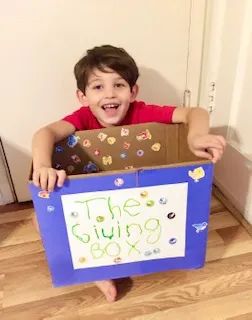
Thanksgiving in 2020: A New Season of Giving
November 13, 2020 | by Maritza (Mitzy) Pardo, guest contributor
As leaves change in color and coffee drinkers order their pumpkin spice lattes, it feels like the typical fall season we are all used to. And then you notice the masks that have become commonplace, the marked areas on public floors for social distancing. Some might say the general feeling of warmth we associate with the holidays has changed. The spirit of gratitude this season may be more difficult to cultivate during these challenging times, nevertheless, it is crucial that we do so. More importantly, teaching our children how to give thanks during hard times will enable them to find joy outside their present circumstances.
Gratitude unlocks the fullness of life. It turns what we have into enough and more. It turns denial into acceptance, chaos to order, confusion to clarity. It can turn a meal into a feast, a house into a home, a stranger into a friend. Gratitude makes sense of our past, brings peace for today, and creates a vision for tomorrow. –Melody Beattie
Beginning with gratitude, many parents initiate the practice of teaching their kids how to say thank you early on – oftentimes before words are even able to be spoken. However, grasping the full meaning of gratitude takes time. Depending on the child's developmental level, the meaning may not come until later. Research shows that preschool-age children may be able to demonstrate gratitude on a basic level, with the prior ability to label their emotions. The key is exposure; if parents frequently utilize opportunities to model various ways to express gratitude, it has proven highly effective.
One caveat is that it is not enough to simply say, "Thank you." When modeling the phrase, you must include what you are thankful for (e.g., "Thank you for picking up your toys," or "Thank you for sharing with your sister"). By detailing what you are thankful for, young learners will begin to correlate the phrase with the action that resulted in gratitude. Lastly, remember to reinforce by acknowledgment. From my previous work in social skills training, I frequently encouraged parents to provide plenty of acknowledgment for the behaviors they wanted to see repeated.
Next, we explore ways in which we can give to others while involving our children.
Throughout 2020 we’ve seen needs that were already issues exacerbated (food, housing, and job insecurities, for example), with the added concern that isolation has brought to the table. Indeed, that last factor has forced changes regarding the ways that organizations and volunteers deliver relief. Challenges aside, there are still opportunities to give back as a family while keeping health and safety a priority.
Many nonprofit organizations have instituted drop-off protocols to maintain safety. Parents can take their children grocery shopping and have them pick out a few non-perishables to donate or “adopt” a child or a nursing home resident for Christmas to shop for and allow your kiddo to help select the gifts. Parents can also clean out their child's closet for clothing items that no longer fit. Please keep in mind that it is important to discuss and explain why you are buying those extra cans of soup or putting those pants that no longer fit in a box. Creating visuals as well can help your child's understanding of where the items are going. I advise labeling a box "The Giving Box" to reinforce the notion that the family is giving or gifting those items to others in need. Perhaps allow your child to decorate the box to help personalize their act of giving.


Cleaning out those closets might also provide the opportunity to deliver items to nearby nursing homes. Many of the elderly have missed opportunities to visit with loved ones due to the pandemic and quarantine rules. Many nursing homes could benefit from donated board games, puzzles, books in large print, new warm socks, and of course, cards crafted by children.
- For more information, The Senior Care Network has published a list of items typically accepted at nursing homes.
And while children are crafting homemade cards and pictures, there is an opportunity to send them to deployed troops overseas. As we know, many troops remain overseas and will not be able to join their families for the holidays. Parents can explain to their children that other mothers and fathers cannot come home but would be happy to receive a handmade picture or card. Additional resources on the topic of military deployment include books such as When You Are Away and I'll Lend You My Daddy.
During life amidst a pandemic, we might think that acts of service aren’t an option, yet there are ways to give of your time and talents, safely and socially distanced. It could be something as simple as raking the leaves or shoveling the driveway for a neighbor. It’s those letters and pictures mentioned above or reaching out to our loved ones who are feeling disconnected. Now is a perfectly acceptable time to photobomb your people with the preciousness of your kiddos.
Last but not least, we identify ways we can give to animals without shelter. As mentioned earlier, cleaning out closets can lead to a surplus of items worthy of donating. Blankets and towels are also accepted at the animal shelter, as well as unopened pet food. Remember that while there are several ways to give, the purpose is to involve your children and extend the practice beyond the nationally recognized holiday.
The category from which to choose should include your child's preference and understanding. Throughout the process, the ongoing conversation should include what we are thankful for and who the recipients will be. While it's been way too easy to focus on all that's been taken away or restricted during this time, we have the opportunity to help ourselves and our children refocus. Throughout November and beyond we can go forth with a spirit of giving and transform our present adversities into opportunities of joy.





